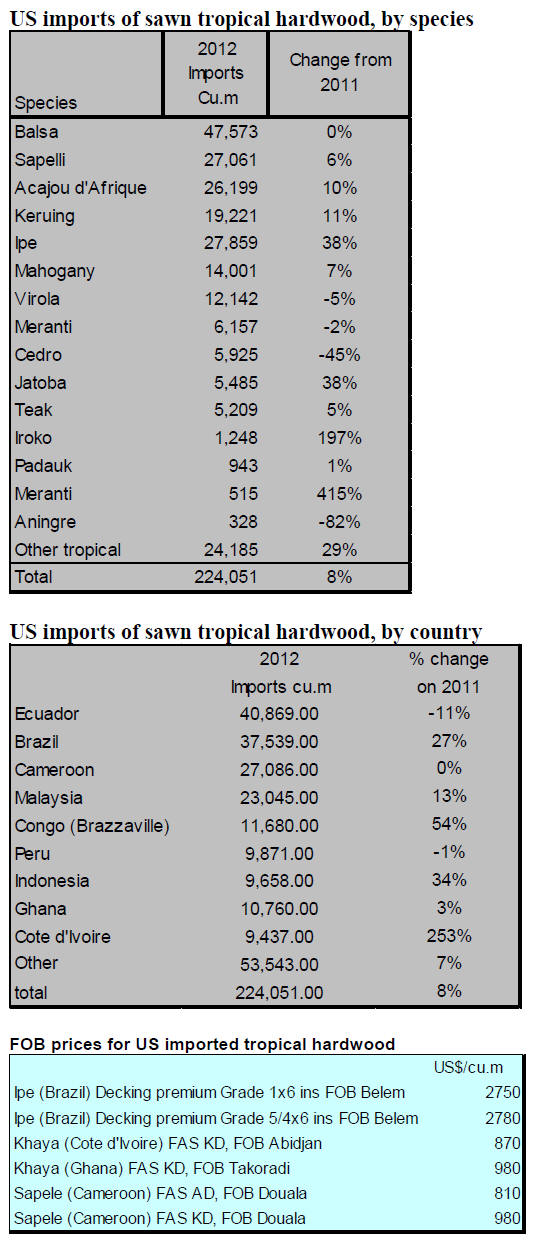|
Report
from
North America
Tropical hardwood sawnwood imports
The US tropical sawn hardwood imports slowed in December, but the
decline is likely seasonal. December imports were 17,516 cu.m., down 6%
from the previous month. Year-to-date imports of tropical sawn hardwood
were up 8% in December compared to 2011.
Imports from Brazil were 3,166 cu.m., up 19% from November. The increase
was not only in ipe (1,941 cu.m.) but also in other (not specified)
tropical species (668 cu.m.).
Jatoba imports from Brazil declined to 346 cu.m. Total 2012 ipe imports
are 38% above 2011 volumes.
Ecuador¡¯s balsa shipments to the US fell by 33% to 2,418 cu.m. in
December.
Imports from Malaysia grew by 7% to 2,418 cu.m. Keruing shipments of
2,222 cu.m. accounted for much of the increase.
December imports from Cameroon were 1,849 cu.m., unchanged from 2011 on
a year-to-date basis. Sapele shipments fell from 1,748 cu.m. in November
to 998 cu.m. in December, while acajou d¡¯Afrique imports increased to
635 cu.m. Ghana¡¯s acajou d¡¯Afrique exports to the US soared to 1,503
cu.m. in December.
Malaysia¡¯s exports to the US increased in November, mainly because of
higher keruing sawnwood shipments (1,855 cu.m.). Indonesia exported 724
cu.m. of sawn hardwood in December, up 34% year-to-date from 2011.
Export growth was in other, various species, while meranti shipments
declined by 65% from November to only 181 cu.m. Annual 2012 US imports
of sawn tropical hardwood by species and the % change from the previous
year are shown in the table below.

Ipe and wood-plastic composites used for boardwalks
The devastation brought by Hurricane Sandy last October included the
destruction of boardwalks in towns along the New Jersey and New York
coast. In New Jersey, almost every town and city along the coast has a
boardwalk.
Although many boardwalks had been destroyed in previous storms, they
were always rebuilt because they are major tourist attractions and often
the economic and social centres of the shore towns.
New Jersey towns are now working on rebuilding and repairing the more
extensive damage from Hurricane Sandy before the summer season.
Ipe from Brazil has been a popular material for the boardwalks since it
is structurally strong and long-lasting in the humid conditions and near
saltwater. As a result, boardwalk repair is a major market for ipe.
The environmental group Rainforest Relief estimated in 2007 that 40% of
New Jersey¡¯s boardwalks are made from ipe.
Towns have increasingly been asked by environmental groups and concerned
citizens to use non-tropical wood or wood-plastic composites (WPC) when
repairing their boardwalks. Several towns are now rebuilding their
boardwalks in WPC.
According to a press release by Trex, the largest manufacturer of WPC,
four towns will use their WPC product to rebuild boardwalks destroyed by
Hurricane Sandy, including the famous Atlantic Beach boardwalk in New
York.
Other towns, however, continue to use ipe, especially if it is FSC
certified. The town of Wildwood, New Jersey, ordered native black locust
wood to avoid the use of tropical species.
But the delivered wood was too low quality, the town was planning to go
back to ipe if no black locust of adequate quality is found.
Aesthetically, WPC does not offer the same experience to users as a
wooden boardwalk. Southern yellow pine has historically been used in
boardwalks, but even when treated it has a short lifespan compared to
ipe and it is less fire-resistant.
In the town of Belmar, New Jersey, officials planned to use certified
ipe to rebuild the boardwalk, but the town switched to WPC after an
environmental group was prepared to fight the use of ipe. The possible
legal battle would have delayed construction, which the town hopes to
complete before May this year.
Overall however, it appears that most towns do not change the material
previously used in boardwalk repairs, whether it is ipe or WPC.
Additional wooden structures on top of the boardwalk, such as pavilions,
will be added later in most towns as the focus is to have the boardwalks
ready for the start of the tourist season this year.
Cross-laminated timber handbook published for US construction
industry
A handbook on design, construction and implementation of cross-laminated
timber (CLT) in residential and non-residential construction in the US
has been published by a group of research institutes and industry
associations (FPInnovations, the American Wood Council, the US Forest
Products Laboratory, APA The Engineered Wood Association, and US
WoodWorks).
The handbook is aimed at building professionals and can be downloaded
for free at www.masstimber.com. A recent building code change will allow
greater use of CLT in non-residential construction in the US,
potentially replacing non-wood materials.
¡¡
|